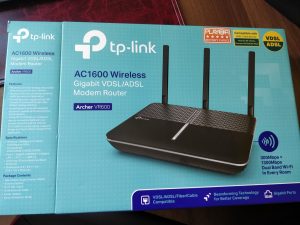TP Link Archer VR600

You might be wondering why I'm blogging about another router just after buying myself something much nicer. The answer, as ever, is one of the handful of friends and family for whom I still do tech support. In their case, it really had to be a single-box solution which does everything, and while MikroTik is all good fun to spend hours configuring for oneself, something much more plug in and go was needed in this case.
The person in question had a Billion 8800NL (ISP supplied), which is well regarded but felt a bit flimsy. More to the point, it didn't seem capable of reliably reconnecting after line drops without being turned off and on again. Things had massively stabilised (maybe one reboot per week required) and I was almost tempted to leave well alone, but even one failure to recover automatically is really too many for this user. It needs to Just Work, especially since we are indulging in the rather adventurous practice of VoIP over ADSL as this person's primary "landline".
A trawl around Amazon for ADSL routers is a rather boring thing. Anything costing less than £100 - and plenty costing that or more - seem to have at least some reviewers ranting about lock-ups, over-heating and dead spots. In the end, we spent £100 on the TP Link Archer VR600, partly because it looked OK and partly because I could go and get one from Argos rather than waiting for delivery.
It's quite nicely built, and the web interface makes reasonable sense. It allows various things including setting it to respond to pings from the internet (essential for my tech support "clients", whose lines I have configured on my monitoring system so I get notified of any outages), and the usual array of port forwarding, WiFi, etc. It was rather sad to find an option in there to have the thing reboot itself on a daily or monthly schedule - surely an admission that they haven't engineered it very well in the first place...
That said, it was really good to find an option for automatic firmware updates - the days of downloading arcane .bin files and uploading them by hand are (or should be) well over, and I'd much rather have an installation like this one take care of itself automatically.
The router also allows remote admin from a specified IP address, which is handy as it allowed me to set it up for remote control from a location of mine with a fixed IP. This is good in theory, but the web interface is horribly broken unless you visit it at http://ip-address-of-router (i.e. anything different in the address bar, caused by assigning some DNS or reaching it indirectly via a port forward, causes it to get upset and fail to load its CSS).
I'll update this post in a couple of weeks with how well it manages to hang on to the ADSL connection (and recover it in the event of blips).
Update, 5 January 2019: The end user now thinks the connection is rock solid reliable. Nagios shows it does still flake out occasionally, maybe once every few days, but these blips all seem to recover automatically without human intervention. The Billion is going on eBay.